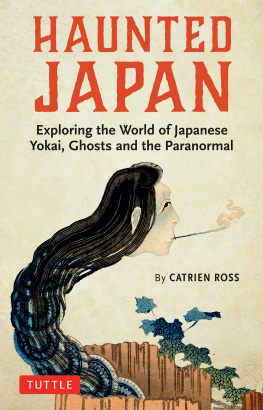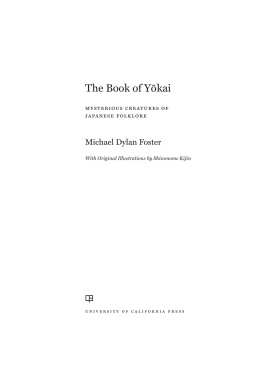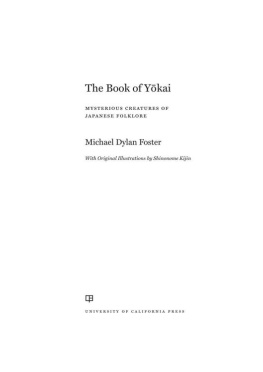
Such beautiful nightmareswhy bother to wake up? Long
before Pokmon took to the streets, the Japanese saw monsters
everywhere and in everything. Scholarly without being beastly
studious, Sekiens classic compendia of outlandish everyday
demons compiled in this one fiendishly clever volume is sure to
enchant even the most rational readers (poor misguided souls!)
I sleep less now that I recognize the tenjo
-name behind the
spots on the ceiling.
ALFRED BIRNBAUM
Editor/translator of Monkey Brain Sushi
A fascinating, scholarly, beautifully illustrated, miscellanea of
strange beasts, quelling demons and otherworldly apparitions.
Japandemonium Illustrated will instruct you, amaze you, and
transport you to a quintessential realm of Japanese lore.
GUILLERMO DEL TORO
Filmmaker
J
apanese folklore abounds with bizarre creatures
collectively referred to as the yokaithe ancestors
of the monsters populating Japanese film, literature,
manga, and anime. Artist Toriyama Sekien (171288) was
the first to compile illustrated encyclopedias detailing the
appearances and habits of these creepy-crawlies from myth
and folklore. Ever since their debut over two centuries ago, the
encyclopedias have inspired generations of Japanese artists.
Japandemonium Illustrated represents the very first time they
have ever been available in English.
This historically groundbreaking compilation includes
complete translations of all four of Sekiens yokai masterworks:
the 1776 Gazu Hyakki Yagyo
(The Illustrated Demon Hordes
Night Parade) , the 1779 Konjaku Gazu Zoku Hyakki (The
Illustrated Demon Horde from Past and Present, Continued) ,
the 1781 Konjaku Hyakki Shu
i (More of the Demon Horde
from Past and Present) , and the 1784 Hyakki Tsurezure
Bukuro (A Horde of Haunted Housewares) . The collection
is complemented by a detailed introduction and helpful
annotations for modern-day readers.
www.doverpublications.com
ART/ASIAN
Sekien
Yoda & Alt (eds.)
The Yokai Encyclopedias of
Toriyama Sekien

ABOUT THE TRANSLATORS
Hiroko Yoda and Matt Alt are the founders of AltJapan Co., Ltd., a Tokyo-
based company that specializes in producing the English versions of Japanese
entertainment, including video games, comic books, literature, and other
consumer products. They are frequent pop-cultural commentators in English and
Japanese media, and the co-authors of Yokai Attack! The Japanese Monster
Survival Guide (Tuttle, 2011), Ninja Attack! True Tales of Assassins, Samurai, and
Outlaws (Tuttle, 2011), and Yurei Attack! The Japanese Ghost Survival Guide
(Tuttle, 2011).
Publishers Note
In order to remain true to the artists original intent and vision, this book is
presented in the traditional Japanese style, with the pages arranged sequentially
from right to left. Thus, what would be considered the last page of the book in
the Western style is actually the first page in this edition. Likewise, what is cus-
tomarily the back cover in Western bookmaking is actually the front cover in the
traditional Japanese style, a design feature that this Dover edition has preserved
for the sake of authenticity.

l
l
,
,
,
,
,
,
,
,
Senry poetry
Sessh-seki (Life-taking Stone)
Seto-taish (General Seto)
Shami-chr ,
Shinkir (Mirage)
Shinto, religion of ,
Shirachigo (Dog God)
Shiranui (The Unknown Fire)
Shiro-uneri (White-twister)
Shiry (Dead Soul)
Shan Hai Jing
Shgor
Shkera
Shokuin (Torch-Shadow)
Shuten-dji
Smithsonian Institutions Freer and Sackler
Galleries
Sgen-bi (Thicket-fire)
Suiko (Water-tiger)
Suzuhiko-hime (Bellprince-princess)
Suzuri-no-tamashii (The Haunted
Inkstone)
Taimatsu-maru (The Torch)
Taka-onna (High Woman)
Taki-rei (Waterfall Spirit King)
Takara-bune (Treasure Ship)
Tamamo-no-mae (The Lady Tamamo) ,
Tanuki (Raccoon-Dog) ,
Ten (Marten)
Tengu-tsubute (Tengu Gravel)
Tenj-kudari (Ceiling-Dropper)
Tenj-name (Ceiling-Licker)
Tera-tsutsuki (Temple-pecker)
Te-no-me (Eyes-in-Hands)
Tengu
Terajima, Ryan
Tesso (Iron Rat)
Toilet
Arrangement of in Japanese homes
God of
Tdai-ki (Candlestick Demon)
Toriyamabiko
Tsuchigumo (Groundspider)
Tsukumo-gami, definition of
Tsun-hanz (Horned Basin)
Tsurube-bi (Wellbucket-fire)
Uba-ga-bi (Hagfire)
Ubume
Umizat (Blind Man of the Sea)
Ungai-ky (Mirror Beyond the Clouds)
Ushinotoki-mairi (The Hour of the Ox) ,
Ushiro-gami (The God Behind You)
Ushi-oni (Ox-Demon)
Utagawa, Toyoharu
Waira
Wakan Sansai Zue
Wanydo (Wheel-monk)
Yamabiko (Ghost-Echo)
Yamauba (Mountain Hag)
Yama-oroshi
Yama-warawa (Mountain Boy)
Yanari (House-Creakers)
Yarike-ch (Captain Yarike)
Yo-Kai Watch
Yokai Attack! The Japanese Monster Survival
Guide
Yonaki-no-ishi (The Stone that Wails at
Night)
Yoshiwara pleasure quarters ,
Yuki-onna (Snow Woman)
Yrei (Ghost)
Zen-fush (Zenkettle)

l
l
Kan
Chikanobu
Gyokuen
Motonobu
Kappa
Kasha
Katawa-guruma (Single-wheel)
Kawatar
Kawauso (Otter)
Kawa-akago (River-baby)
Kazenb (Bonze-before-the-fire)
Kejr (Hairy Harlot)
Kerakera-onna (Cackling Woman)
Keu-kegen
Kid (The Oni Kid) 1905
Kinu-tanuki (Silken Tanuki)
Kitagawa, Utamaro
Kitsune-bi (Foxfire)
Kobayashi, Issa
Kodama (Tree-Spirit)
Koinry
Kokuri-baba (Hag-in-the-house)
Konjaku Hyakki Shi (More of the Demon Horde
from Past and Present)
Konjaku Gazu Zoku Hyakki (The lllustrated De
mon Horde from Past and Present, Continued)
Korka (Old Lantern Fire)
Kosameb (Drizzle-monk)
Kosenj-no-hi (Old Battleground-fire)
Koto-furunushi (Old man Koto)
Kosode-no-te (The Kimonos Hands)
Kurayar (Saddle-guy)
Kutsu-tsura (Sandalface)
Kurozuka
Kyogoku, Natsuhiko
Kyka poetry
Definition of















